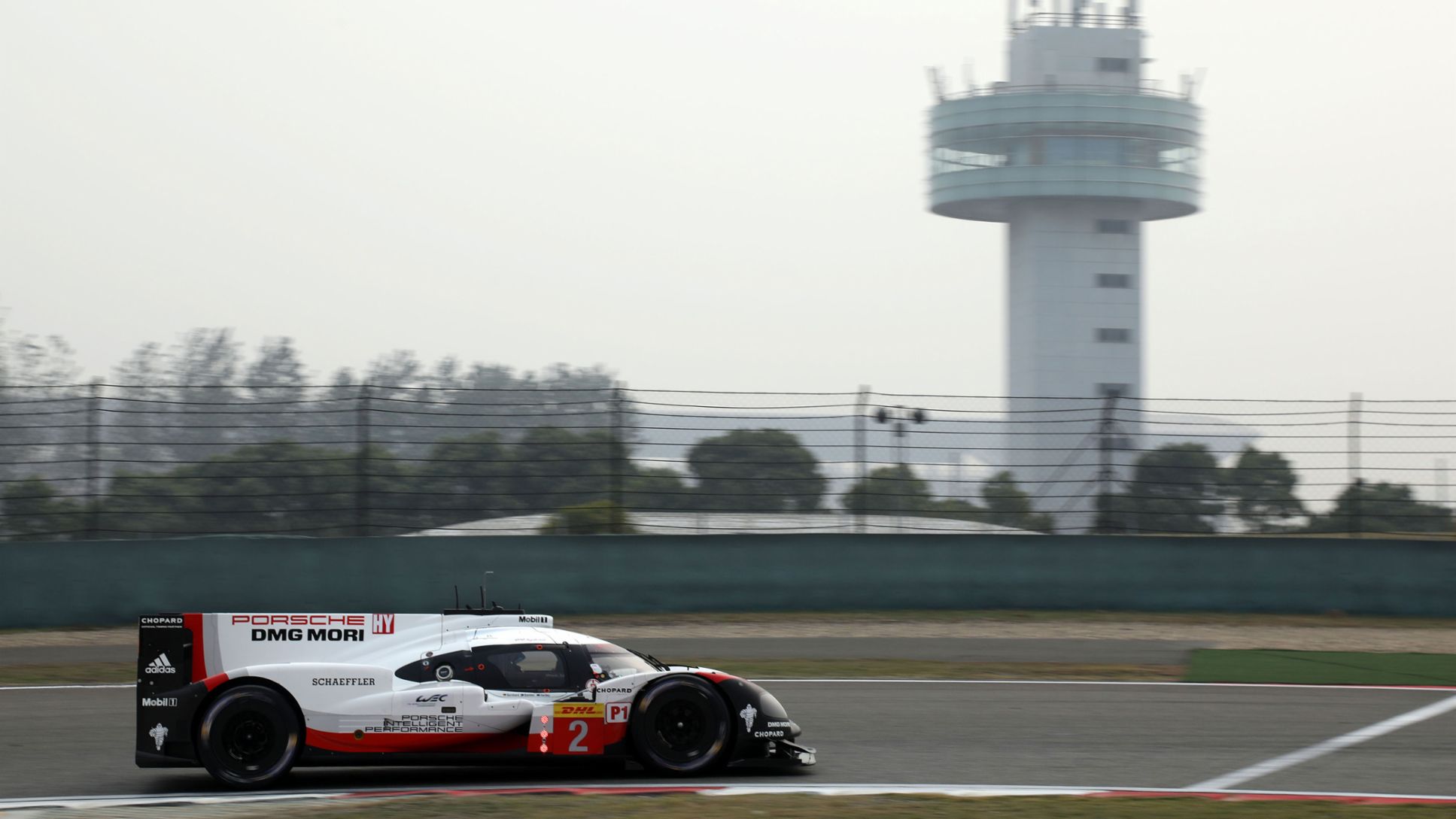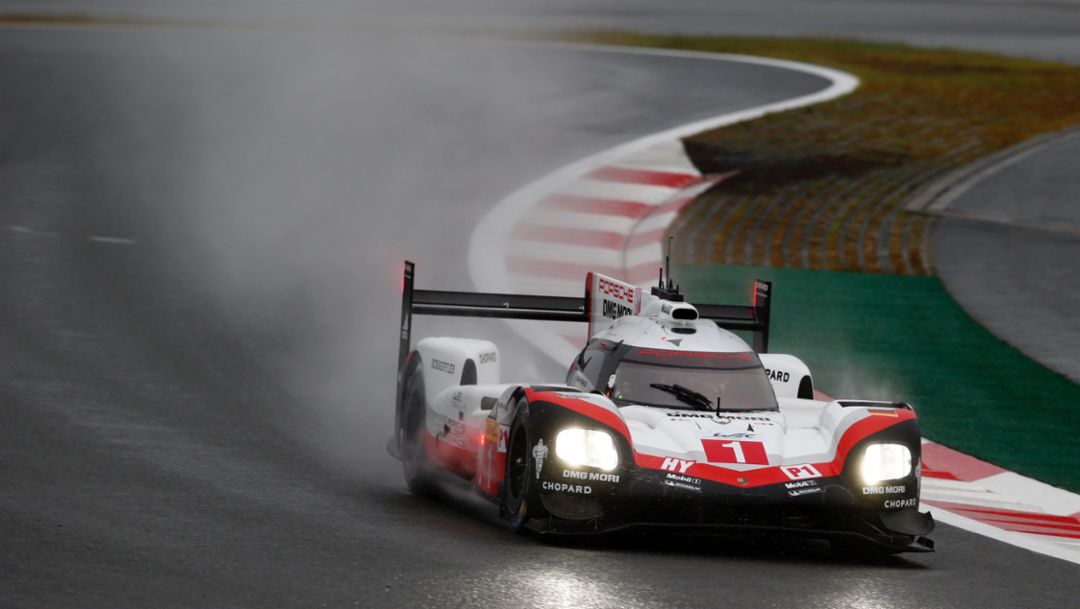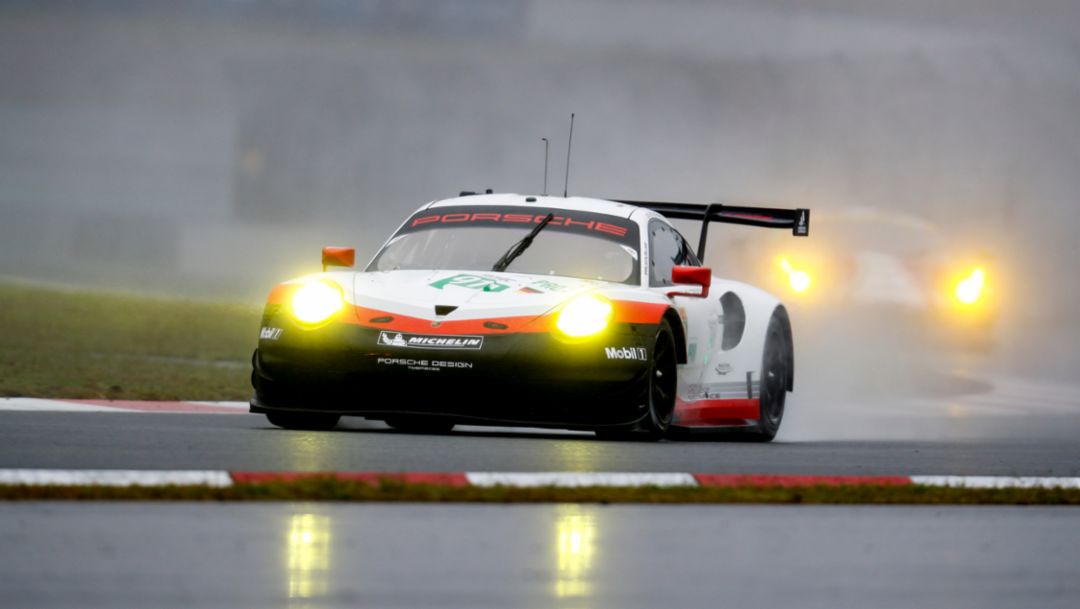LMP Team
There’s no room for sentiment yet: On the Chinese Formula One circuit, the team from Weissach has to defend the championship titles for drivers and manufacturers.
For the Porsche LMP Team the first day of the FIA World Endurance Championship’s penultimate round in Shanghai went according to plan: tyre comparison, set-up work and qualifying simulation were ticked off. So far the Porsche 919 Hybrids appeared stronger on longer runs than on a single fast lap. Porsche, as well as this year’s Le Mans winners, Earl Bamber (NZ), Timo Bernhard (DE) and Brendon Hartley (NZ), have a chance to take an early win of the world championship in Sunday’s six-hour race.
Because of a radio communication problem between race control and the marshals and medical staff around the track, the first 90-minute practice session was postponed by 90 minutes to start at 12:30 hrs. The Porsche trio of Neel Jani (CH), André Lotterer (DE) and Nick Tandy (GB) came second (1:47.414 minutes) ahead of Bamber/Bernhard/Hartley (1:47.637 minutes). The second practice session got underway as planned at 15:30 hrs, leaving the teams very little time for analyses and preparation work. In the second session Bamber/Bernhard/Hartley finished third (1:45.269 minutes) and Jani/Lotterer/Tandy were fourth (1:45.616 minutes). The day’s best lap times were set by Toyota.
Both sessions ran on a dry track with ambient temperatures between 17 to 19 degrees Celsius. It became cloudy with gusty winds during the afternoon.
The championship leading Porsche drivers Earl Bamber (NZ), Timo Bernhard (DE) and Brendon Hartley (NZ) have scored 172 championship points while the best placed Toyota drivers have 133 points. If this Toyota takes maximum points in China – a race win from pole position is rewarded with 26 points – Bamber/Bernhard/Hartley need to finish the race in at least third position for them to clinch the drivers’ world championship title. The trio of the second Porsche 919 Hybrid, reigning world champion Neel Jani (CH), André Lotterer (DE) and Nick Tandy (GB), currently rank fourth with a score of 98 points. In the manufacturers’ standings, Porsche leads with 270 points ahead of Toyota on 211.5 points. To secure the manufacturers’ title, Porsche would need to have no less than a 44 points advantage after six hours of racing.
The Porsche LMP Team after practice
Fritz Enzinger, Vice President LMP1: “After three consecutive Le Mans overall wins we also want to get both world championship titles for the third time after 2015 and 2016. This would be the crown of our LMP1 programme and this is what we are aiming for. At the most recent six-hour race in Japan, we had our first match point but we didn’t succeed. Instead we lost ground to our competitor Toyota. In Shanghai we’ve got our next chance. To stay fully focussed remains our top priority.”
Andreas Seidl, Team Principal: “It was a very normal Friday for us. We completed our programme with both cars. Aside from testing different car set-ups and tyre compounds we did a qualifying simulation early in FP2. We gathered lots of data and in terms of pace we want to make a step forward tomorrow.”
Timo Bernhard (36, Germany): “Today was quite an intense working day. The competition is pretty close. We still have some work to do, but we will manage that. Off line on the track there is a lot of rubber that you don’t want to pick up. So you have to manage traffic with care.”
All the drivers' quotes in the press release (see downloads).
GT-Team
A gripping fight for the Sports Car World Endurance Championship WEC title heads into the penultimate round at the Shanghai International Circuit. At the wheel of the 911 RSR, designed from scratch by Porsche Motorsport in Weissach, the Porsche pilots Richard Lietz (Austria) and Frédéric Makowiecki (France) aim to earn more critical points towards winning the GT Drivers’ World Championship in the Chinese economic metropolis against strong opposition from Aston Martin, Ford and Ferrari. The pair travels to Shanghai ranking second in the series, just five points off the leader. This season also sees a close battle for honours in the GTE-Am class, in which Porsche customer teams go head-to-head for the FIA Endurance Trophy with the 2015-spec 911 RSR.
The Porsche drivers
Four works drivers and a Porsche Young Professional compete at the Shanghai International Circuit. In the GTE-Pro class, Richard Lietz (Austria) and Frédéric Makowiecki (France), who currently rank second in the Drivers’ World Championship, aim to defend their title chances in the cockpit of the #91 Porsche 911 RSR. Their team colleagues Michael Christensen (Denmark) and Kévin Estre (France) share the second new 911 RSR with the starting number 92. As the most promising Porsche customer team in the fight for the FIA Endurance Trophy, Dempsey Proton Racing campaigns the 2015-spec 911 RSR (#77) in the GTE-Am class. The Porsche Young Professional Matteo Cairoli (Italy) as well as Christian Ried and Marvin Dienst from Germany share the cockpit. Dempsey Proton Racing currently ranks second in the points, with the drivers leading the classification after achieving victories at the Nürburgring and in Mexico City. Ben Barker (Great Britain), Khaled Al Qubaisi (Abu Dhabi) and Nick Foster (Australia) compete in the #86 Porsche 911 RSR fielded by Gulf Racing.
Comments before the race
Dr. Frank-Steffen Walliser, Vice President Motorsport and GT Cars: “The title race for the world championship remains gripping. After their strong performance recently at Fuji, our drivers Richard Lietz and Frédéric Makowiecki still have the best chances to secure the crown of GT sport. The main thing for them in Shanghai is to secure another top result to be in the best possible for the season finale in Bahrain. As a team, we’ll support them to the very best of our ability.”
Marco Ujhasi, Director GT Factory Motorsports: “Shanghai will probably be the second high-temperature race of the season after Austin, Texas. It looks like we’ll have to run the hardest tyre compound there to make it over the laps. Only those who get it right with the tyres will have a chance to win on this challenging circuit.”
Drivers' quotes in the press release (see downloads).
Cars
The Porsche 919 Hybrid
The class 1 Le Mans Prototype (LMP1) develops a system power of around 900 HP (662 kW) that comes from a compact two-litre turbo charged V4-cylinder (nearly 500 HP/368 kW) engine and two different energy recovery systems – brake energy from the front axle combined with exhaust energy. The combustion engine drives the rear axle while the electro motor boosts the front axle with an output of more than 400 HP (294 kW). The electrical energy that comes from the front brakes and the exhaust system is temporarily stored in a liquid-cooled lithium ion battery.
The Porsche 911 RSR
Porsche Motorsport built the 911 RSR a completely new development on the basis of the high-performance 911 GT3 RS sports car: the suspension, body structure, aerodynamic concept, engine and transmission have all been designed in Weissach from scratch for this season. Depending on the size of the restrictor, the motor, which is now positioned in front of the rear axle, puts out around 375 kW (510 hp). Thanks to the particularly large rear diffuser combined with a top-mounted rear wing, the level of downforce and the aerodynamic efficiency were significantly improved. The new RSR scored its maiden victory at the American IMSA SportsCar Championship race at Lime Rock on 22 July. The best results so far in this year’s Sports Car World Endurance Championship WEC were second place at the rounds in Nürburgring, Austin, and most recently at Fuji.
Balance of Performance (BoP)
The Balance of Performance applies to the GTE-Pro class of the WEC Sports Car World Endurance Championship as well as the GTLM class of the IMSA SportsCar Championship. BoP was introduced by the FIA with the aim of achieving a level playing field for the different vehicle concepts, and thus ensuring balanced and fair races. The intention is that it should not make a fundamental difference if a vehicle is powered by a turbocharged or normally aspirated engine, or if the engine is mounted on the front axle or in front of the rear axle. The basic aerodynamic shape of the vehicles should also not play a decisive role.
After an initial grading by the FIA, the balance of performance is adjusted at the races by means of telemetry - not only using lap times, but also acceleration profiles and engine mappings. This data input is automatically analysed and incorporated into the Balance of Performance. The most frequently used means of adjusting the performance level is through adding or subtracting weight. In keeping with the rule-makers’ intention, the key to success on the racetrack is not about the individual potential of a vehicle, instead it’s about the performance of the drivers, the race strategy, a perfect setup or the skill of the team with their pit stops.
The race
The 5.541-kilometre Shanghai International Circuit was opened in 2004, however, it already made headlines during its construction: Due to the swampy subsoil, 43,000 support piles had to be rammed into the earth over the entire facility. However, no amount of effort was too much for China in its quest to lure Formula 1 to Shanghai. The Grand Prix circuit is one of many prestige projects with which the nation wanted to demonstrate its economic power to the world at the beginning of the new millennium.
Schedule
Local time:
Friday, November 3 2017
11:00-12:30 hrs 1st free practice
15:30-17:00 hrs 2nd free practice
Saturday, November 4 2017
10:00-11:00 hrs 3rd free practice
14:30-14:50 hrs Qualifying LMP1 & LMP2
Sunday, November 5 2017
11:00-17:00 hrs Race
TV and live streaming
The official WEC App can be downloaded free of charge with an extended (not
free of charge) version available which includes full live streaming and full timing.
The live stream is voiced by the FIA WEC TV team including live interviews
from the pits.
The WEC races can be followed on various international TV channels in Europe,
Asia, Australia and New Zealand, North and South America as well as in
the Middle East and Africa.
Facts and figures
The WEC efficiency regulations limit the amount of energy that can be used
per lap. On the 5.45 kilometres long lap of the Shanghai International Circuit,
the Porsche 919 Hybrid can use 4.96 megajoule of electrical power from energy
recovery systems and 1.391 kg/1.921 litres of petrol.
At normal race speed, the 919 Hybrid is due for refuelling after 31 laps.
Refuelling and changing tyres may only be done sequentially, not at the same
time. Only four mechanics may work simultaneously when changing tyres and
also may use only one wheel gun at a time. That takes a lot longer than in F1,
for example.
The drivers are normally only changed when new tyres are needed.
These different types of tyres can be used: three different compounds of slick
tyres for dry conditions, a hybrid tyre (no profile either but softer cover) for
mixed conditions and wet weather tyres. Four sets of dry weather tyres are
available per car for qualifying and the race, this is two sets less than in 2016.
A lap of the Shanghai International Circuit, used for Formula One Grands Prix
since 2004, has 16 corners – nine right-handers and seven left-handers – of
which the well known “snail corner” at the beginning of each lap counts as a
double right-hander. From a bird’s eye view the track’s layout is reminiscent of
the Chinese characters of “shàng” that translates into “upward” or “up” and also
is part of the city name of Shanghai.
The circuit is located about 40 kilometres outside the city centre.
The World Endurance Championship
Sports prototypes and GT vehicles contest the Sports Car World Endurance Championship (WEC) in four classes: LMP1 (eg. Porsche 919 Hybrid), LMP2, LMGTE-Pro (eg. 911 RSR) and LMGTE-Am (eg. 911 RSR model year 2015). They all compete together in one race but are classified separately. At Le Mans, double points are awarded in all classes towards the championship.
Info
Consumption data
911 GT3 RS: Fuel consumption combined 12.7 l/100 km; CO2 emissions 296 g/km


